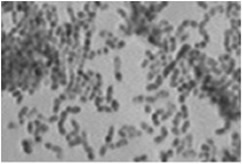 |
Gene Networks in Extremophiles |
 |
Extremophiles are microbes that can survive under conditions which would otherwise be inhospitable to other organisms. These conditions can include, but are not limited to extremely high or low temperatures, ranges in pH and atmospheric pressure, water and nutrient availability, and even levels of UV irradiation (reviewed in Satyanarayana et al., 2005; Wilson and Brimble, 2009). Their ability to adapt to such extreme and diverse conditions provides a platform for understanding successful responses to extreme stress, and also has allowed them to serve as model organisms for bioengineering enzymes, biofuel production, and bioremediation (reviewed in Rossi et al., 2005; Satyanarayana et al., 2005).
One extremophile of significant interest, the Gram-positive Actinomycetales bacterium Rhodococcus opacus PD630 (hereafter R. opacus), was isolated from a gas plant soil sample in Germany (Alvarez et al.,1996). This organism is notable for its large genome (9.27 Mb) as well as its ability to catabolize a wide variety of hydrocarbons (Holder et al., 2011). R. opacus is also a specifically interesting organism to study for biofuels production due to its ability to accumulate large amounts of TAGs (Kurosawa et al., 2010), and a recent metabalomics study has shown it to also have a highly developed lipid metabolism, particularly under nitrogen limiting conditions (Holder et al., 2011). As other Rhodococcus species have been successfully isolated from dry soil environments and shown to have a variety of adaptive responses (Yam et al., 2001), R. opacus displays remarkable responses to osmotic stresses, including significant repression of overall metabolic activity, biosynthesis of compatible solutes, and the development of smaller cell sizes under dehydrating conditions (Alvarez et al., 2004).
In a recent sampling of soils at high volcanic elevations in the Atacama region of Argentina and Chile, a novel Rhodococcus species was identified (Lynch et al., 2012). These regions experience extreme temperature fluctuations as well as high solar irradiation (Lynch et al., 2012). According to the authors, this novel high elevation Rhodococcus species shows about 95% pairwise identity to the 16S gene of R. opacus and grown optimally at 0-5°C (Lynch, unpublished). Since R. opacus grows at 30°C, and has such a variety of well documented adaptive responses, we are interested in discovering what allows for the selective differences in these closely related organisms. We have begun characterization of the novel high-elevation Rhodococcus sp and comparison to its relative R. opacus is required in order to identify the traits that are required for its success in what are some of the harshest conditions on the planet. Results from our findings will provide new insight into successful strategies of stress survival, as well as pointing the way towards potentially new approaches to bioengineering and synthetic biology.